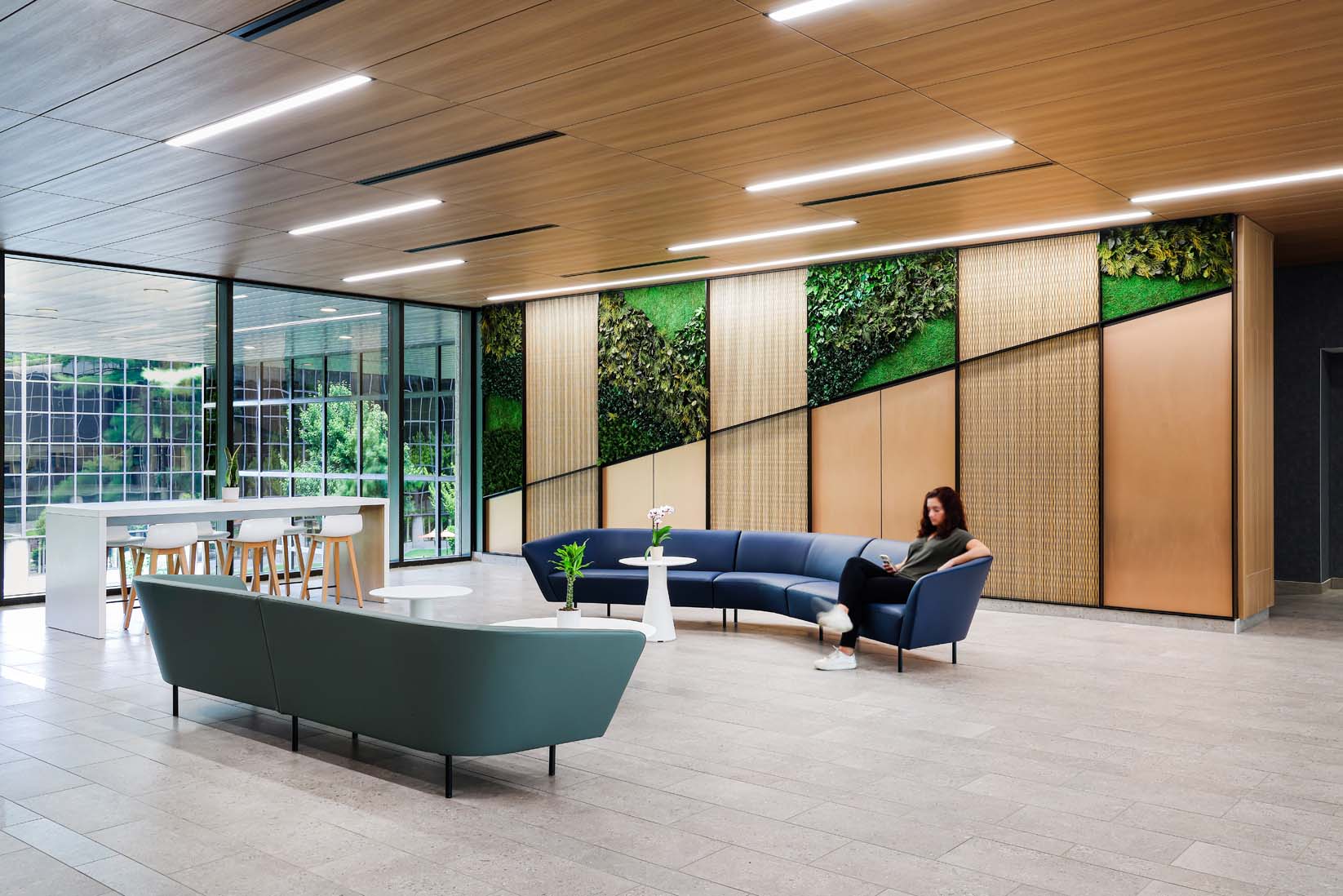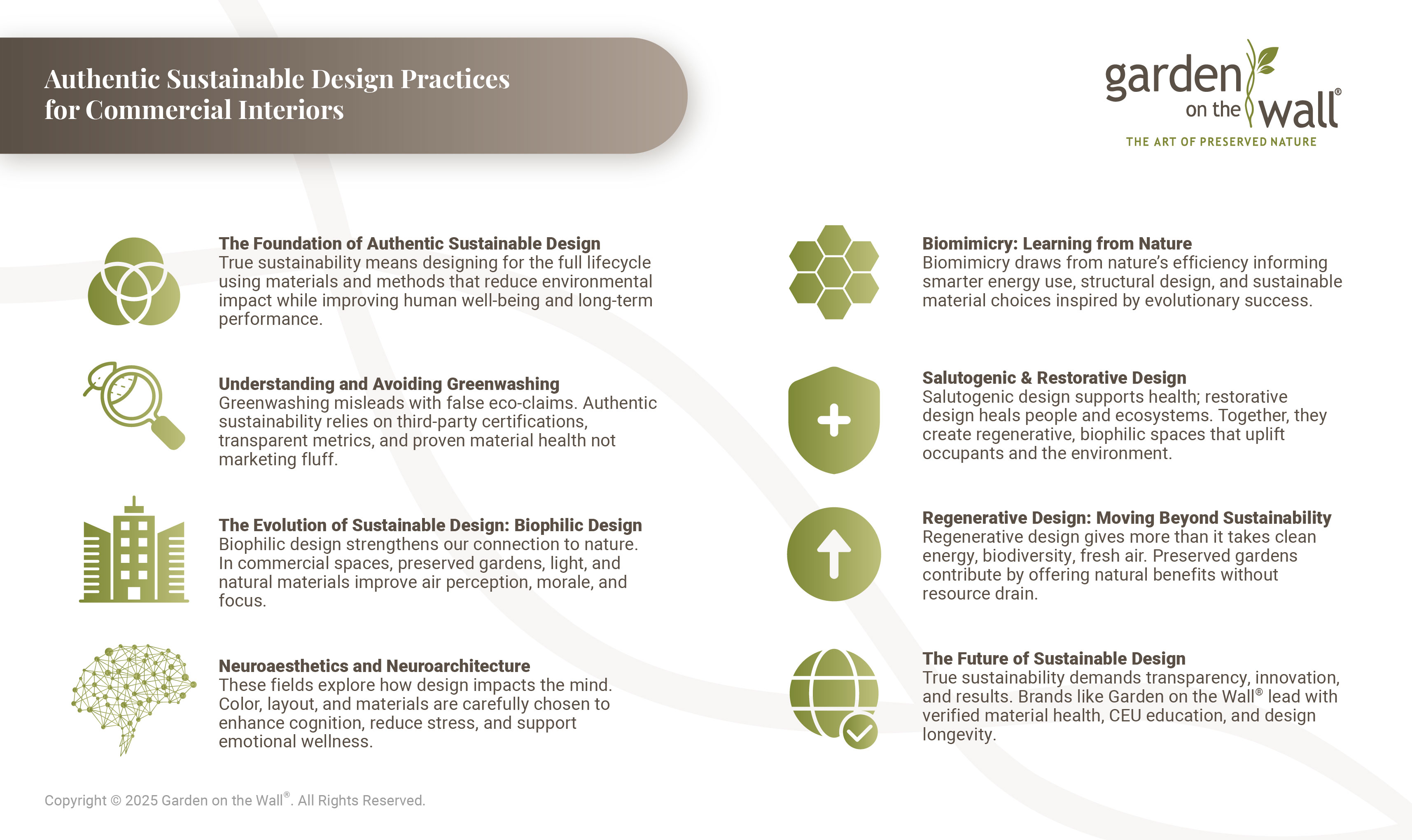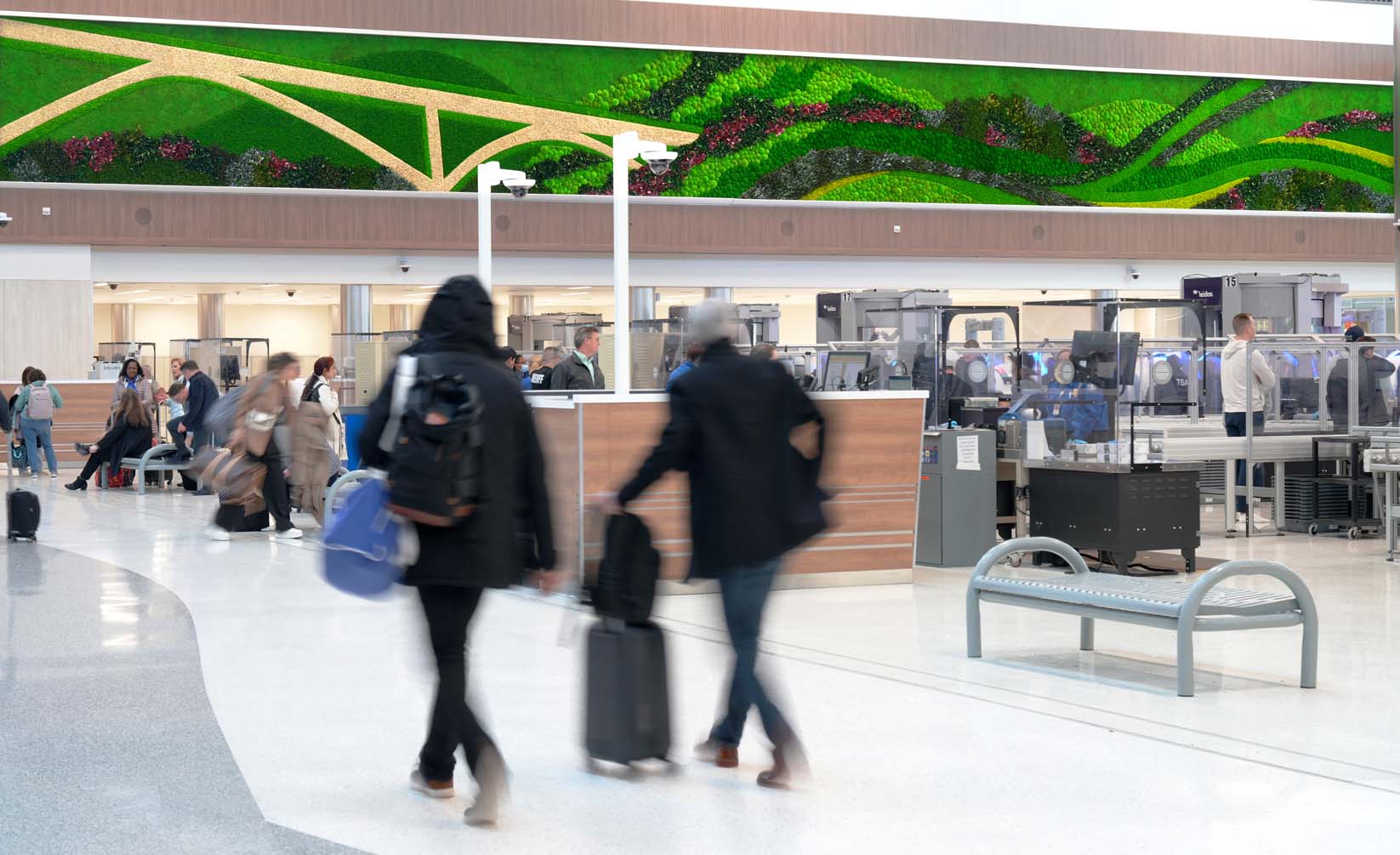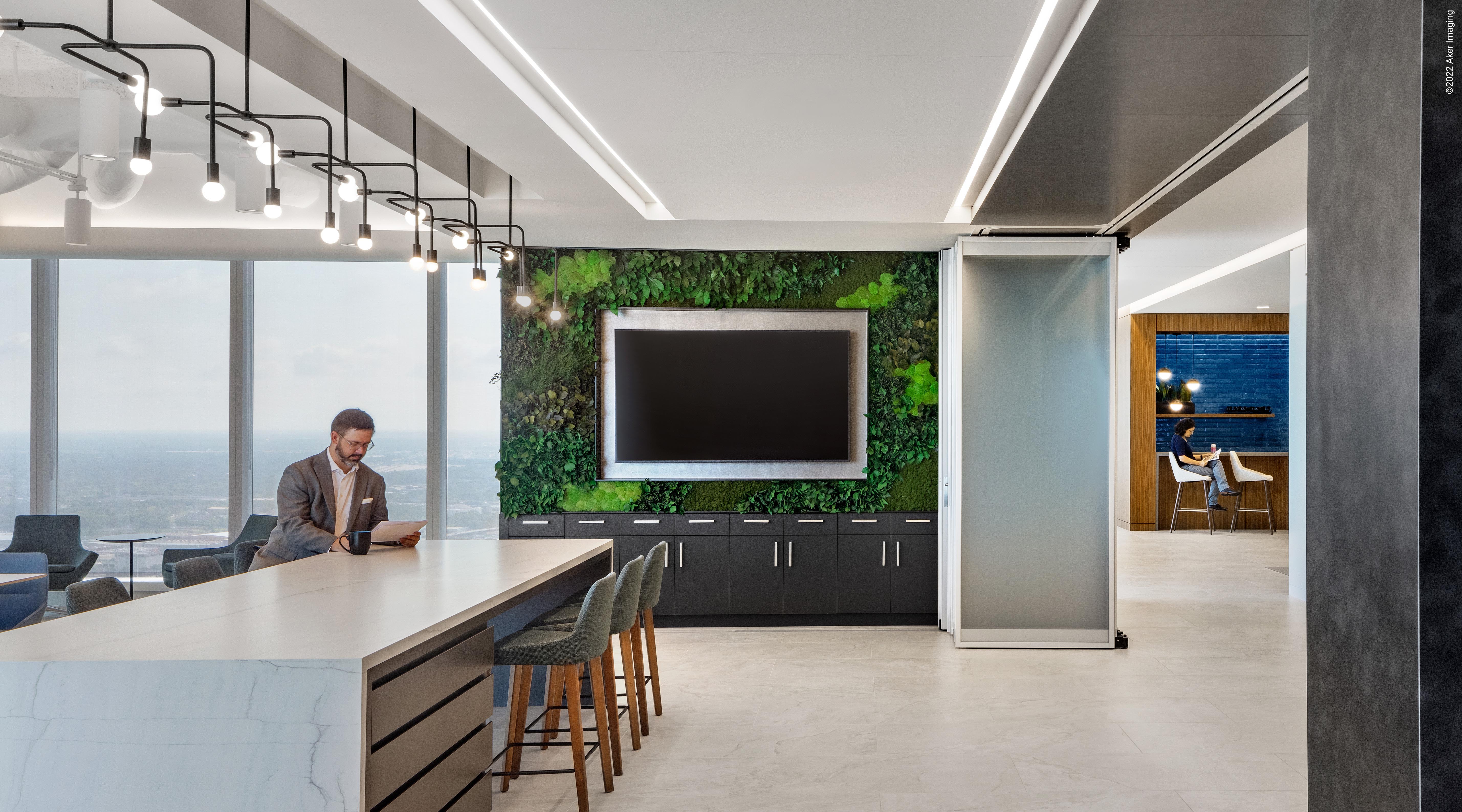Garden on the Wall®
Authentic Sustainable Design Practices for Commercial Interiors

Key Takeaways Before You Read the Full Article
30 Second Executive Summary
Authentic sustainable design integrates regenerative, restorative, and science-backed strategies to create interiors that actively support occupant well-being and environmental health while avoiding greenwashing.
🌍 True Sustainability: A lifecycle approach ensures design decisions optimize energy, materials, and waste, creating spaces that actively contribute to occupant health and ecological balance.
🚫 Avoiding Greenwashing: Verified certifications, transparent material health documentation, and measurable outcomes distinguish authentic sustainability from misleading claims.
🌿 Biophilic, Salutogenic & Restorative Design: Natural elements, preserved greenery, and thoughtful design enhance mental well-being, reduce stress, and create visually compelling environments without resource-heavy upkeep.
🧠 Neuroaesthetics & Biomimicry: Evidence-based design leverages neuroscience insights and nature’s systems to improve cognitive performance, emotional well-being, and space efficiency.
♻️ Regenerative Design: Moving beyond “doing less harm,” regenerative design creates environments that generate positive ecological and human health impacts, setting a new benchmark for commercial interiors.
🔍 Future of Design: Success depends on transparency, innovation, and proven solutions, with preserved gardens offering a scalable, low-maintenance approach to sustainable design excellence.
Ready to embrace authentic sustainability and set a new standard for eco-conscious interiors? The full article explores science-driven, regenerative solutions for creating truly future-ready commercial spaces.
Authentic Sustainable Design Practices for Commercial Interiors
In recent years, sustainability in design has become more than just a trend, it's a necessity. Amidst the urgency to address climate change and resource scarcity, design professionals are stepping up to incorporate sustainable building practices into commercial interiors. However, the term "sustainability" has been overused to the point where the lines between genuine eco-friendly practices and greenwashing are blurred.
This blog is prepared with the aim of unraveling the essence of true sustainability and exploring cutting-edge design trends like Biophilic Design, Neuroaesthetics, Restorative Design, Regenerative Design, Salutogenic Design, and Biomimicry.
The Foundation of Authentic Sustainable Design
True sustainability in design transcends simple energy conservation or material selection. It embraces a holistic approach that considers the entire lifecycle of a building, from initial construction through its operational life and eventual deconstruction. This comprehensive viewpoint ensures that every design decision contributes to both environmental preservation and occupant well-being.
Modern sustainable design integrates smart technology, renewable energy sources, and innovative waste management systems to optimize resource usage. The goal isn't just to minimize environmental impact but to create spaces that actively contribute to occupant health, overall well-being of the environment and productivity while respecting ecological boundaries.
Understanding and Avoiding Greenwashing
Greenwashing is a deceptive practice where companies falsely promote their products or initiatives as environmentally friendly. It has become a significant challenge in the design industry, where companies often make unsubstantiated or exaggerated environmental claims. This deceptive practice not only misleads consumers but also undermines the efforts of genuinely sustainable businesses. Understanding how to identify greenwashing is crucial for making informed design decisions.
Key indicators of authentic sustainability include transparent third-party certifications, detailed material health declarations, and verifiable performance metrics. Companies like Garden on the Wall® demonstrate genuine commitment through comprehensive documentation, proven longevity, and clear material health credentials.

The Evolution of Sustainable Design Practices - Biophilic Design
Biophilic design represents a fundamental shift in how we approach interior spaces. By integrating natural elements into built environments, this approach creates spaces that resonate with our innate connection to nature. The incorporation of natural light, preserved gardens, and organic materials goes beyond aesthetics to enhance occupant well-being and productivity.
When properly implemented, biophilic design can significantly reduce stress levels, improve air quality perception, and boost overall morale within a workspace. Preserved gardens and moss walls offer an ideal solution, bringing nature's benefits indoors without the maintenance challenges of living plants.
Neuroaesthetics and Neuroarchitecture
These emerging fields explore how our built environment affects our brain function and behavior. By understanding the neurological impact of design elements, architects and designers can create spaces that enhance cognitive performance, support emotional well-being, and reduce stress.
The principles of neuroaesthetics and neuroarchitecture inform everything from color selection to spatial organization, ensuring that each design element contributes to occupant health and productivity. These science-backed approaches help create environments that truly support human flourishing.
Biomimicry: Learning from Nature
Biomimicry takes inspiration from nature's time-tested patterns and strategies to solve design challenges. This approach has led to innovations in energy efficiency, material development, and space optimization. By studying and emulating natural systems, designers can create more sustainable and efficient built environments.
The application of biomimetic principles extends beyond mere imitation to understanding and implementing the fundamental strategies that make natural systems so effective and sustainable.
Salutogenic and Restorative Design
These complementary approaches focus on creating environments that actively promote health and well-being while supporting environmental regeneration. Salutogenic design emphasizes factors that support human health, while restorative design seeks to repair and rejuvenate both the environment and its occupants.
Together, these approaches create spaces that not only avoid harm but actively contribute to both human and environmental health. The integration of preserved nature elements supports these goals by providing consistent connection to natural elements without resource depletion.
Regenerative Design: Moving Beyond Sustainability
Regenerative design represents the next evolution in sustainable architecture, pushing beyond the goal of "doing less harm" to actively restoring and renewing environmental systems. This ambitious approach seeks to create buildings and spaces that enhance their surroundings, contributing positively to both ecological and human health.
At its core, regenerative design aims to create spaces that produce more than they consume – more clean energy, more filtered water, more fresh air, and more biodiversity. In the context of commercial interiors, this approach manifests through thoughtful integration of systems and materials that support both environmental and human health, with preserved gardens playing a unique role by offering biophilic benefits without resource demands.
The Future of Sustainable Design
The path forward in sustainable design requires integrating these various approaches while maintaining authenticity and effectiveness. Success lies in choosing solutions and partners who demonstrate real commitment through transparency, innovation, and verified results.
Garden on the Wall® exemplifies this commitment through:
- Industry-leading longevity standards
- Comprehensive third-party testing
- Complete material health transparency
- Educational initiatives including CEU programs and extensive resource sharing
Conclusion
Creating truly sustainable commercial interiors requires moving beyond surface-level initiatives to embrace comprehensive, authentic solutions. By understanding and implementing genuine sustainability principles while avoiding greenwashing pitfalls, designers can create spaces that benefit both occupants and the environment. The key lies in choosing proven solutions that demonstrate real commitment to sustainability through transparency, innovation, and verified results.
Garden on the Wall®'s recognition as a 2023 Planet Positive Award recipient underscores their position as an industry leader in sustainable practices. Their commitment to transparency, comprehensive third-party testing, and unmatched longevity standards sets a benchmark for others in the field.
By prioritizing material health, occupant well-being, and environmental responsibility, companies can successfully balance commercial success with genuine sustainability. Garden on the Wall®'s approach to preserved gardens and moss walls exemplifies how innovative solutions can address both environmental concerns and design needs, providing a model for others in the industry to follow.
For more insight on this topic, we recommend reading: "Salutogenic Design and the Future of Sustainable Architecture & Interior Design". For additional information and related resources, please visit: www.gardenonthewall.com
Related Posts

Sustainability and Biophilic Design Connection

Creating Mindful Spaces: The Role of Biophilic Design & Sustainability


